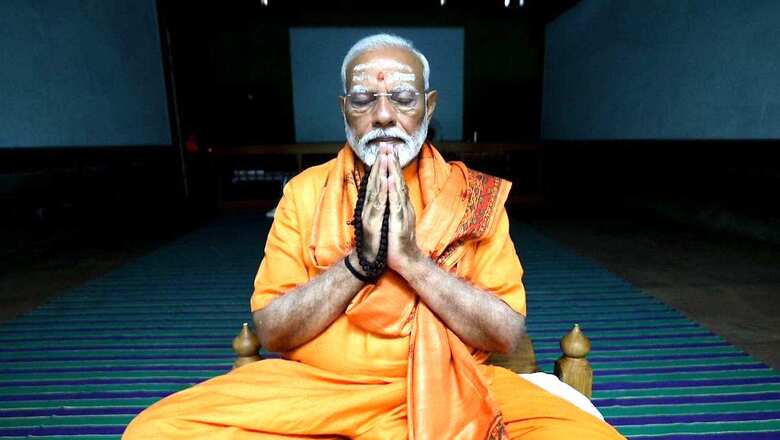
views
In my book Modi & India: 2024 and the Battle for Bharat, there is a reference to a pivotal moment in Narendra Modi’s tenure in office. The image of the prime minister executing a dandvat pranam before the idol of Lord Ram in August 2020. The setting was the Bhoomi pujan of the precise spot in Ayodhya where Lord Ram was born and where a grand temple dedicated to him was to be built. That day Prime Minister Modi transformed from being just a devotee to a new Hindu suratrana – the defender of the faith.
After all, it was under his watch that the Ram Janambhoomi had been wrestled free. In the final leg, the much-storied 500-year-long struggle even took a detour through India’s labyrinthine judicial system.
Modi was certain that the construction of a grand Ram temple would set the stage for the final denouement – the consecration of a veritable second republic. A “new idea of India” reclaimed from the rootless Westernised elite that equated any legitimate appreciation of the grandeur of Hindu civilisation as anti-secular.
Indeed, as an unapologetic Hindu, Prime Minister Modi has given the majority community the confidence to reclaim their Hinduness– “a view on life” that was largely externed from Nehru’s India.
For decades altogether, Nehruvians had succeeded in taking the Hindu out of the Indian. Anyone talking about the need to build the Ram temple, about implementing a uniform secular code, anyone seeking to draw inspiration from the Vedas to design a system of learning or even advocate Sanatana Dharma was labelled a Right-winger, Sanghi, Bajrangi, Hindu fundamentalist and so on.
In Modi’s India, not only have Hindu symbols been accorded visibility but also the Hindu. Modi’s Sisyphean service to the Hindu cause comes naturally to him as he is a disciplined member of the Rashtriya Swayamsevak Sangh (RSS), a nationalist organisation whose paterfamilias has always championed the Second Republic inseparable from its Hindu heritage.
The RSS’s ‘Hindu Rashtra’ isn’t a ‘Hindu Pakistan’ but a nation where all citizens, castes and creeds are equally hypothecated to a larger Indic civilisational dharma or ethos.
Unfortunately, the Left deliberately equates a Hindu Rashtra with a Hindu Rajya or state. And beyond this sleight of hand, the Left also equates Sanatana Dharma with religion. The Left maintains that India should be “dharma nirpeksh”. The original Indian Constitution also explicitly pledged this before it was amended. But dharma is a code of ethics. How can a country be dharma nirpeksh – or one that is dharma agnostic? Wouldn’t a country divorced from morality or dharma be ethically compromised? A feckless swamp of moral dissolution.
The RSS’s ‘dharma rashtra’ is a modern-day Ram Rajya. And Modi, ever the disciple, never tires of emphasising his personal commitment to realising the Sangh’s vision. Modi’s speeches frequently invoke Hindu symbols, festivals, and historical figures to emphasise a connect between the present and India’s Sanatani civilisational past. Modi references the Ramayana and Mahabharata, the labour of righteous Hindu saints and monarchs. The idea is to position these Hindu cultural narratives as national symbols.
The ceremony in India’s new Parliament to install the Sengol (the Chola era sceptre held by Kings) as a modern-day national symbol with roots in Bharat’s Hindu golden age is a classic example.
At a policy level too, Modi’s administration works to reappropriate India’s ancient cultural and spiritual heritage. For instance, the government has increased funding for the restoration of Hindu temples and historical sites. Institutions like the Indian Council of Historical Research (ICHR) have been tasked with revisiting the portrayal of Indian history. The renaming of cities to reflect their Hindu heritage is a part of this effort.
For example, Allahabad was renamed Prayagraj, and most recently, Port Blair was renamed Sri Vijiyapuram. These symbolic gestures also serve the additional purpose of distancing dharmic Bharat from wave upon wave of Islamic and British “settler” colonialism.
The course correction has extended beyond the spiritual sphere. A panoply of laws are being pushed through to undo the impress of colonialism.
Nehru, hypnotised by Western modernity, tried to graft its tenets onto the declared “palimpsest” that was India. Secularism – the complete separation of church and state – was one of the borrowed ideas. When Nehru realised that the Western notion of secularism was not the right fit for spiritual and religious Indians, his government’s policy tweaks distorted the new republic’s legislative landscape.
Now, Modi hopes that laws like the Uniform Civil Code will address Hindu resentment against state-sponsored minority exceptionalism.
To ensure that the flame of Hindu consciousness doesn’t flicker out, the Modi-led NDA has made significant changes to India’s educational curriculum. The young must be exposed to India’s ancient Hindu knowledge systems, including through the incorporation of subjects like yoga, Sanskrit, and Vedic sciences. The New Education Policy (NEP) 2020 has taken a step in this direction. All these efforts have succeeded in consolidating Hindus like never before.
But will this Hindu convergence pose a challenge to Modi’s commitment to carry everyone along? Much depends on how Modi balances Hindu cultural assertion with the philosophy’s inherent foundational commitment to pluralism and diversity.
Views expressed in the above piece are personal and solely those of the author. They do not necessarily reflect News18’s views.



















Comments
0 comment